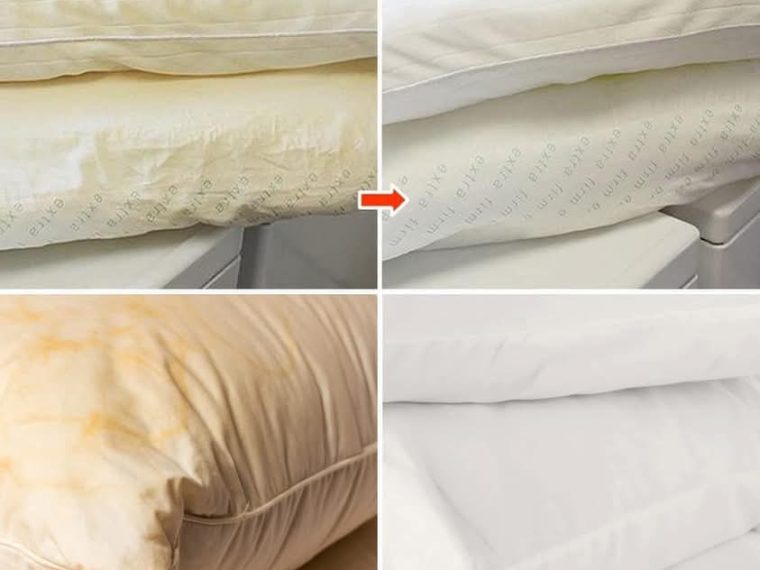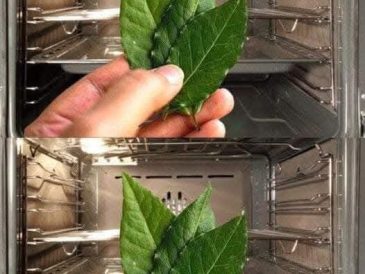Over time, pillows can accumulate stains, dirt, sweat, and bacteria, leaving them looking yellowed and less than fresh. Regular cleaning isn’t just about appearance—it’s also about hygiene. Disinfecting and thoroughly cleaning your pillows ensures a healthier sleeping environment and can help extend the life of your bedding.
Here’s a step-by-step guide to restoring your pillows to their former brightness and fluffiness with a simple yet effective cleaning trick.
Why Do Pillows Turn Yellow?
The yellow stains on pillows are typically caused by:
- Sweat: A natural occurrence during sleep.
- Body Oils: Absorbed by the pillow over time.
- Drool: Common for side or stomach sleepers.
- Hair Products: Residue from shampoos, conditioners, or oils.
The Quick Whitening Trick
This method uses everyday household items to deeply clean, whiten, and disinfect pillows.
What You’ll Need:
- Hot water
- 1 cup of laundry detergent
- 1 cup of powdered dishwasher detergent
- 1 cup of bleach (or a bleach alternative for sensitive fabrics)
- ½ cup of borax
- Large washing machine or bathtub
- Dryer (optional)
Step-by-Step Instructions:
1. Check Pillow Care Labels
Before starting, ensure your pillows are machine washable. Most synthetic and down pillows are washable, but memory foam pillows require spot cleaning.
2. Prepare the Cleaning Solution
- Fill a washing machine, bathtub, or large container with hot water.
- Add the laundry detergent, dishwasher detergent, bleach, and borax. Mix thoroughly until all powders are dissolved.
3. Soak the Pillows
- Submerge your pillows in the solution.
- Use a heavy object (like a clean plate) to ensure the pillows stay underwater.
- Let them soak for 30 minutes to 1 hour. This step helps break down stains and oils.
4. Wash the Pillows
- For machine washing, place the pillows in the washing machine and run them through a hot water cycle with an extra rinse to remove any residual cleaning agents.
- If washing manually, scrub gently, then rinse thoroughly with clean water.
5. Dry the Pillows Properly
- Use a dryer on low heat if the pillow’s care label allows it. Add a couple of clean tennis balls or dryer balls to help fluff the pillows.
- For air drying, place the pillows in direct sunlight. Sunlight helps naturally bleach and disinfect.
Additional Tips for Maintaining Pillows
- Use Pillow Protectors
- Invest in high-quality pillow protectors to shield against sweat and dirt.
- Wash them monthly to prevent buildup.
- Regular Washing Schedule
- Wash pillows every 3-6 months to maintain cleanliness and hygiene.
- Wash pillowcases weekly to reduce exposure to oils and bacteria.
- Fluff Pillows Daily
- Fluffing your pillows daily helps distribute filling and prevents lumps.
- Replace Pillows When Necessary
- No matter how well you care for them, pillows should be replaced every 1-2 years for optimal support and hygiene.
FAQs
1. Can I use this trick on memory foam pillows?
No, memory foam pillows should not be submerged. Instead, spot-clean stains with a mild detergent solution and let them air dry completely.
2. What if I don’t have borax?
You can substitute borax with baking soda for similar whitening and deodorizing effects.
3. Is bleach safe for all pillows?
Bleach can damage delicate fabrics like silk or some down materials. Use a bleach alternative for sensitive materials.
4. How do I remove stubborn odors?
Add ½ cup of white vinegar to the rinse cycle or soak to neutralize persistent odors.
Conclusion
With this quick and effective trick, you can rejuvenate your pillows, making them look as good as new. This method removes tough stains, eliminates odors, and disinfects thoroughly, ensuring a clean, fresh, and comfortable sleeping environment. Keep your bedding spotless, and you’ll enjoy better sleep and improved health.





